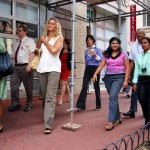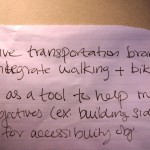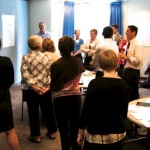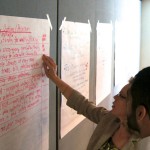With my neverending interest in walking as a leisure and work tool, I was asked to attend the America Walks Policy Platform – Development Meeting, held at the headquarters of AARP last week. Since my philosophy is “if I can walk to it, I’ll do it,” I went.
I felt it was probably inappropriate to do anything but walk to this meeting, so I skipped public transportation and enjoyed the DC humidity for maybe a few more blocks than was practical…..
As it says in the title of this post, AmericaWalks ( @AmericaWalks) (at http://www.americawalks.org) has as its sole mission to advance and walking, and has recently taken the step to go from a coalition of interests to having its own professional staff. You can read its strategic plan here.
The day (or half-day for me) was extremely educational in that I learned what societal supports go into making the advice “you should walk more” actually be possible. I did not realize, for example, all of the work and thinking underway in the transportation sector devoted toward safe walking / bicycling in our communities.
I learned about the term “active transportation” that encompasses bicycling and walking, and also the term “pedestrian advocacy” which struck me as a little incongruous thinking from the health perspective, but makes sense coming from the transportation perspective.
A few statistics
- 2.1% of the federal transportation program funds in FY2010 (up from 0.1% in 1992) were for active transportation.
- 30% of pediatric traffic fatalities occur when children are not in cars.
There are huge impacts to walking that come from speed regulation (less speed limits = more fatatlities) and from the way States are incentivized to apportion (or not) federal funds for active transportation.
There’s a lot that can happen that make a physician’s simple advice to walk more a lot less doable in some communities.
At the same time, I noticed the heavy emphasis in this area on transportation issues and funding. It seemed to me that the participation of the health and health care sector would be useful in the future.
For example, what percentage of federal health program dollars are devoted to active transportation, and should there be a percentage? How can the health system and health services world participate and contribute to the discussion about the value of walking alongside our transportation peers?
We can learn a lot from each other….
Before I left, Scott Bricker, AmericaWalks’ Director, indulged my playing of the video montage of The Center for Total Health (no one in this group had ever heard of or seen the touch video walking wall!) and a “walkthrough” of my approach to walking meetings.
Speaking of walking meetings, the last photo below is of an impromptu walking meeting created by a fire alarm at AARP Headquarters in downtown DC….whatever it takes!



